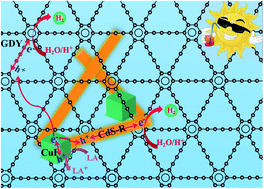Construction of a tandem S-scheme GDY/CuI/CdS-R heterostructure based on morphology-regulated graphdiyne (g-CnH2n−2) for enhanced photocatalytic hydrogen evolution
Abstract
As a new two-dimensional (2D) carbon hybrid material, graphdiyne (GDY) has attracted much attention due to its good conductivity, adjustable electronic structure and special electron transfer enhancement properties. It has great potential in the field of hydrogen evolution by photocatalytic water splitting due to its special properties. In this work, GDY was successfully prepared by the cross-coupling method, and then 0.05CIGCS-R with excellent photocatalytic performance was obtained based on morphology modulation. The photocatalytic hydrogen evolution rates of 0.05CIGCS-R (16.16 mmol g−1 h−1) were 762 and 4.56 times higher than those of pure GDY (21.2 μmol g−1 h−1) and CdS-R (3.54 mmol g−1 h−1), respectively. The emphases of this work are as follows: firstly, the internal reasons for the great improvement of the CdS-R hydrogen production activity with the introduction of GDY were explored by photoelectrochemistry. Secondly, the internal factors affecting the photocatalytic hydrogen evolution activity of complexes with different morphologies were further studied by photoelectrochemistry. Thirdly, the XPS of the composite material after photocatalytic hydrogen evolution was used to analyze the reason for the slight decrease in the stability of the composite catalyst. Then, last but not least, a tandem S-scheme heterojunction is cleverly constructed through morphology control, which provides an absolute driving force for the separation and migration of photogenerated carriers. This work provides a new strategy for the application of GDY in the field of photocatalysis and the ingenious construction of a tandem S-scheme heterojunction.



 Please wait while we load your content...
Please wait while we load your content...